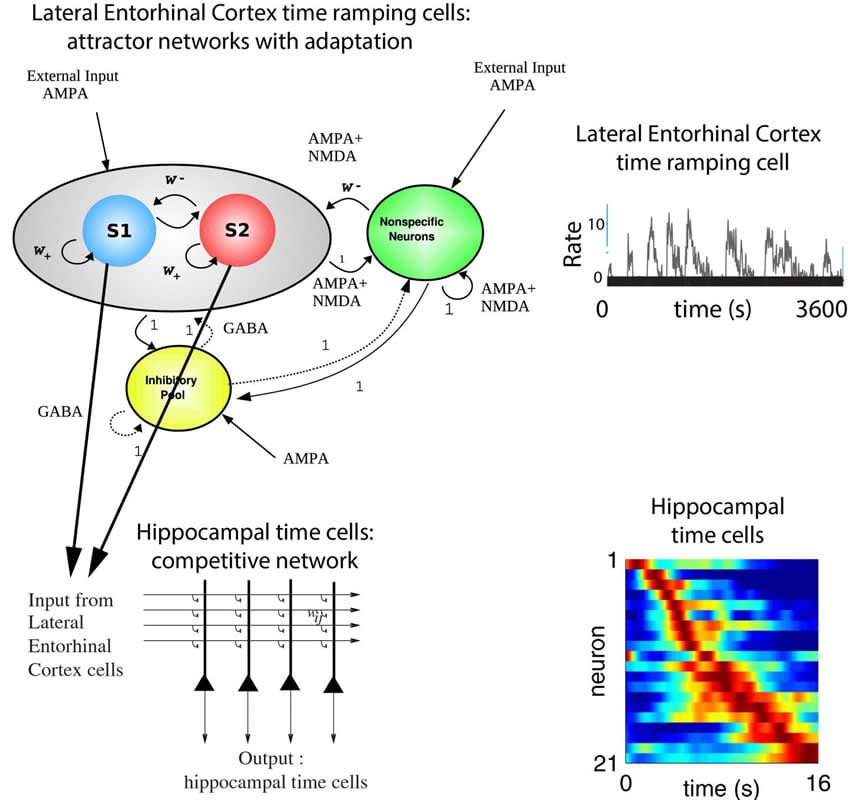Summary: A new theory and model helps explain how entorhinal time ramping cells produce hippocampal time cells. The hippocampal cells allow for memory association between places and people to help recall event sequences.
Source: University of Warwick
For centuries understanding how the order of events is stored in memory has been a mystery. However, researchers from the Department of Computer Science at the University of Warwick have worked out how the order of events in memory could be stored and later recalled in the hippocampal memory system in the brain.
The new research published in the journal ‘Cell Reports’ titled ‘The Generation of Time in the Hippocampal Memory System’ builds on the discovery by Nobel prize winners May-Britt and Edvard Moser that an input region to the hippocampus – the lateral entorhinal cortex (LEC) – has time ramping cells that slowly change their rates of activity over hundreds of seconds; and on the discovery that hippocampal time cells fire at separate times in a sequence.
In the new research, a theory and model was developed of how entorhinal time ramping cells produce hippocampal time cells which can be associated with places and people to help remember the sequence in which the people and places occurred during the remembered episode.
The theory demonstrates how we can remember what happened to us during the day in the correct order, and how we can provide an eye witness memory for a series of events.
The researchers show how the transformation of the code of the memory between the two brain areas – the LEC and the hippocampus – is achieved by a well-known type of neural network present in the brain, a competitive network.
The competitive network learns to allocate hippocampal neurons to respond to different combinations of the firing of the time ramping cells, and thus a temporal sequence can be formed.
The theory also accounts for the slow activity changes in time ramping cells by adaptation mechanisms, and shows how spontaneous memory recall can occur with the correct order of items in the memory.
Understanding the brain’s memory and related mechanisms is helping not only to understand disorders of memory, but also is providing new approaches to understanding and treating mental disorders including depression and schizophrenia.

Further details of Prof. Rolls’ approach to a better understanding of depression building on these foundations is provided in his new book, ‘The Brain, Emotion and Depression’ published in 2018. It shows for example how sad memories dominate in depression, and provides suggestions for treatment.
Professor Edmund Rolls from the Department of Computer Science at the University of Warwick comments:
“This is an exciting time for research on the brain: we are starting to understand the underlying brain mechanisms for many types of behaviour including memory and emotion, and this has great potential for better treating brain disorders.”
Source:
University of Warwick
Media Contacts:
Alice Scott – University of Warwick
Image Source:
The image is credited to University of Warwick.
Original Research: Open access
“The Generation of Time in the Hippocampal Memory System”. Edmund T. Rolls and Patrick Mills.
Cell Reports. doi:10.1016/j.celrep.2019.07.042
Abstract
The Generation of Time in the Hippocampal Memory System
Highlights
• Attractor networks with adaptation form time ramping cells in lateral entorhinal cortex
• Competitive networks in the hippocampus then generate hippocampal time cells
• The competitive learning produces sparse representations suitable for memory
• Forward and reverse replay can arise as emergent properties in this system
Summary
We propose that ramping time cells in the lateral entorhinal cortex can be produced by synaptic adaptation and demonstrate this in an integrate-and-fire attractor network model. We propose that competitive networks in the hippocampal system can convert these entorhinal ramping cells into hippocampal time cells and demonstrate this in a competitive network. We propose that this conversion is necessary to provide orthogonal hippocampal time representations to encode the temporal sequence of events in hippocampal episodic memory, and we support that with analytic arguments. We demonstrate that this processing can produce hippocampal neuronal ensembles that not only show replay of the sequence later on, but can also do this in reverse order in reverse replay. This research addresses a major issue in neuroscience: the mechanisms by which time is encoded in the brain and how the time representations are then useful in the hippocampal memory of events and their order.






